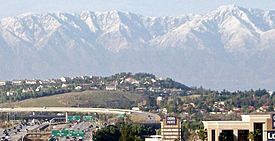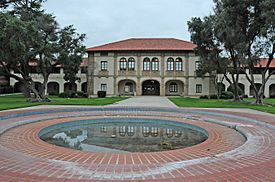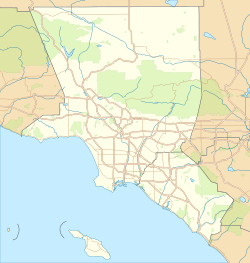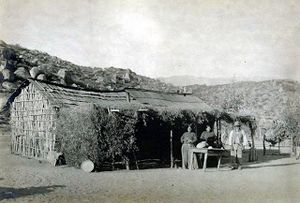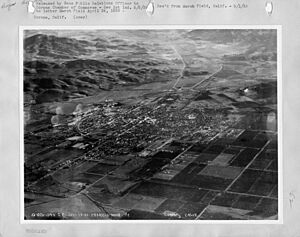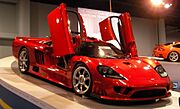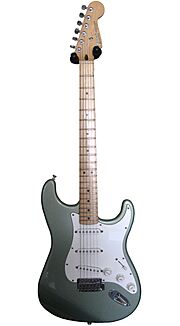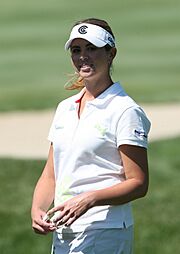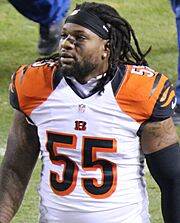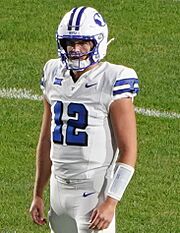Corona, California facts for kids
Quick facts for kids
Corona, California
|
|||
|---|---|---|---|
|
Top: view of Corona; bottom: Corona Historic Civic Center Theater
|
|||
|
|||
| Nicknames:
Crown Town, The Circle City, Crown Colony, Queen Colony, Indianapolis of the West
|
|||
| Motto(s):
"To Cherish Our Past, To Plan Our Future"
|
|||
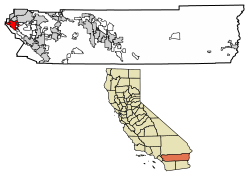
Location of Corona in Riverside County, California
|
|||
| Country | United States | ||
| State | California | ||
| County | Riverside | ||
| Government | |||
| • Type | Council–manager | ||
| Area | |||
| • City | 39.96 sq mi (103.50 km2) | ||
| • Land | 39.94 sq mi (103.45 km2) | ||
| • Water | 0.02 sq mi (0.05 km2) 0.27% | ||
| Elevation | 679 ft (207 m) | ||
| Population
(2020)
|
|||
| • City | 157,136 | ||
| • Rank | 3rd in Riverside County 34th in California 161st in the United States |
||
| • Density | 3,934.20/sq mi (1,519.02/km2) | ||
| • Metro | 4,224,851 | ||
| Time zone | UTC−8 (Pacific) | ||
| • Summer (DST) | UTC−7 (PDT) | ||
| ZIP codes |
92877–92883
|
||
| Area code | 951, 909 | ||
| FIPS code | 06-16350 | ||
| GNIS feature IDs | 1652691, 2410232 | ||
| Website | City Government Tourism site |
||
Corona is a city in Riverside County, California, in the United States. Its name means "Crown" in Spanish. In 2020, about 157,136 people lived there. Corona is near Riverside and Norco. It's also close to the Cleveland National Forest and the Santa Ana Mountains.
Corona is often called the "Circle City." This is because of its unique street layout. A large, circular road called Grand Boulevard goes around the center of the city. Even though it's a mostly residential city, Corona also has many businesses. Some big companies like Fender Musical Instruments Corporation (which makes guitars) and Monster Beverage Corporation (which makes drinks) have their main offices here. The company Saleen, which builds fast sports cars, is also based in Corona.
Contents
What's in a Name?
Corona means crown or wreath in Spanish. The city was first called South Riverside. But citizens wanted their city to have its own special name. They chose Corona because of the unique circular road, Grand Boulevard. This road is about one mile across and circles the middle of the town, like a crown.
Corona's Past
Early Inhabitants
Before the late 1700s, the area where Corona is now was home to Native American groups. These included the Tongva and Payómkawichum people. They lived in villages along the Temescal Creek. One important village was called Paxauxa, which was shared by both groups. Another village, Pamajam, was located high in the Santa Ana Mountains.
Spanish and Mexican Times
In the late 1700s, Spanish soldiers and missionaries came to the area. They built missions like Mission San Juan Capistrano. Native Americans were brought to these missions. Later, in 1816, Leandro Serrano was allowed to use the land for cattle grazing. He had to clear out local bears and mountain lions for his herds.
After Mexico took control from Spain, large pieces of land were given to wealthy landowners. In 1848, a man named Bernardo Yorba was given the land that includes modern-day Corona.
How Corona Started
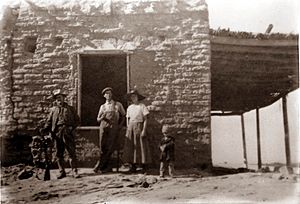
Corona was founded in 1886. This was during a time when many citrus fruit farms were growing in Southern California. The city was once known as the "Lemon Capital of the World." There's even a museum that shows how important lemons used to be to the local economy.
The city's unique circular street, Grand Boulevard, is about 2.75 miles (4.4 km) around. This design was created by Hiram Clay Kellogg, a civil engineer.
The South Riverside Land and Water Company started Corona. They bought land from the Rancho La Sierra and Rancho Temescal areas. They also made sure the new town had water by building dams and pipelines.
At first, Corona was called "South Riverside." It got its post office in 1887. In 1893, it became part of the new Riverside County. Then, in 1896, the city was renamed "Corona." This was to honor its circular Grand Boulevard. This road was even used for international car races in the early 1900s!
The 1900s and Beyond
In the 1900s, Corona became a popular place for famous people. For example, the actors Lucille Ball and Desi Arnaz had a ranch here. They often played golf at the Cresta Verde Golf Course.
Corona is now known as the "Gateway to the Inland Empire." Before the 1980s, it was mostly farms with citrus trees, ranches, and dairy farms. But as land prices in Los Angeles and Orange counties became very high, many people moved to Corona. By the late 1990s, Corona had become a major suburb of Los Angeles.
In the early 2000s, some people in Corona thought about creating a new county. They wanted to separate from Riverside County. This idea was also considered by other cities nearby. However, this plan never happened.
Corona's Location and Weather
Corona is located in the western part of Riverside County, just east of Orange County. The city covers about 38.9 square miles (100.8 square kilometers). Most of this area is land, with a small amount of water.
Corona has a warm Mediterranean climate. This means it has mild winters and hot summers. Most of the rain falls during winter and early spring.
- Winter days are usually pleasant, with temperatures in the 60s Fahrenheit (around 15-20°C). Nights are colder, and it can get frosty. Snow is very rare in the city itself, but the nearby Santa Ana Mountains sometimes get a light dusting.
- Spring brings nice weather, with daytime temperatures in the 70s Fahrenheit (around 20-25°C).
- Summer is hot, with average highs in the low to mid-90s Fahrenheit (around 32-35°C). Sometimes, temperatures can go over 100°F (38°C).
- Autumn has warm days and cooler evenings. Strong winds called Santa Ana winds can blow through the area a few times each year.
| Climate data for Corona, California | |||||||||||||
|---|---|---|---|---|---|---|---|---|---|---|---|---|---|
| Month | Jan | Feb | Mar | Apr | May | Jun | Jul | Aug | Sep | Oct | Nov | Dec | Year |
| Record high °F (°C) | 91 (33) |
93 (34) |
100 (38) |
100 (38) |
107 (42) |
110 (43) |
118 (48) |
113 (45) |
114 (46) |
108 (42) |
99 (37) |
94 (34) |
118 (48) |
| Mean daily maximum °F (°C) | 66 (19) |
69 (21) |
71 (22) |
77 (25) |
80 (27) |
87 (31) |
92 (33) |
93 (34) |
90 (32) |
83 (28) |
74 (23) |
67 (19) |
79 (26) |
| Mean daily minimum °F (°C) | 40 (4) |
43 (6) |
45 (7) |
48 (9) |
52 (11) |
57 (14) |
62 (17) |
64 (18) |
60 (16) |
52 (11) |
45 (7) |
42 (6) |
51 (11) |
| Record low °F (°C) | 19 (−7) |
25 (−4) |
25 (−4) |
28 (−2) |
28 (−2) |
39 (4) |
41 (5) |
41 (5) |
41 (5) |
29 (−2) |
26 (−3) |
22 (−6) |
19 (−7) |
| Average precipitation inches (mm) | 3.01 (76) |
3.06 (78) |
2.32 (59) |
1.02 (26) |
.35 (8.9) |
.04 (1.0) |
.10 (2.5) |
.12 (3.0) |
.24 (6.1) |
.54 (14) |
1.07 (27) |
2.08 (53) |
13.95 (354) |
| Average precipitation days | 6.9 | 7.0 | 5.5 | 3.7 | 1.2 | 0.3 | 1.0 | 1.2 | 1.7 | 2.2 | 4.1 | 6.2 | 41 |
| Mean monthly sunshine hours | 200 | 210 | 270 | 310 | 305 | 295 | 370 | 350 | 290 | 250 | 210 | 205 | 3,265 |
| Source: The Weather Company | |||||||||||||
Corona's Economy
Many companies have their main offices or large operations in Corona.
- TCL: A Chinese technology company.
- Monster Beverage: Makes popular drinks like Monster Energy.
- Circle K: A well-known convenience store chain.
- Saleen: Builds special, high-performance sports cars.
- Fender: Famous for making electric guitars, amplifiers, and other music gear.
- Zumiez: A store that sells clothing and accessories for youth and action sports.
- Troy Lee Designs: Makes gear and clothes for motocross and mountain bike riders.
- SPJA (Society for the Promotion of Japanese Animation): A group that promotes Japanese anime and related cultures. They organize Anime Expo, a huge anime convention.
Top Employers
Here are some of the biggest employers in Corona:
| # | Employer | # of Employees |
|---|---|---|
| 1 | Corona-Norco Unified School District | 5,478 |
| 2 | Corona Regional Medical Center | 1,265 |
| 3 | Monster Energy | 1,075 |
| 4 | City of Corona | 961 |
| 5 | Fender USA Corona | 955 |
| 6 | TWR Framing Enterprises | 800 |
| 7 | All American Asphalt | 755 |
| 8 | Veg Fresh Farms | 527 |
| 9 | Thermal Structures | 392 |
| 10 | Kaiser Permanente | 286 |
Corona's People
| Historical population | |||
|---|---|---|---|
| Census | Pop. | %± | |
| 1900 | 1,434 | — | |
| 1910 | 3,540 | 146.9% | |
| 1920 | 4,129 | 16.6% | |
| 1930 | 7,018 | 70.0% | |
| 1940 | 8,764 | 24.9% | |
| 1950 | 10,223 | 16.6% | |
| 1960 | 13,336 | 30.5% | |
| 1970 | 27,519 | 106.4% | |
| 1980 | 37,791 | 37.3% | |
| 1990 | 76,095 | 101.4% | |
| 2000 | 124,966 | 64.2% | |
| 2010 | 152,374 | 21.9% | |
| 2020 | 157,136 | 3.1% | |
| U.S. Decennial Census | |||
In 2020, Corona had a population of 157,136 people. This was an increase from 152,374 people in 2010.
The city is very diverse. In 2020, about 46.5% of the population was Hispanic or Latino. Other large groups included White (31.7%), Asian (11.8%), and Black or African American (5.2%).
In 2010, about 30% of the people in Corona were under 18 years old. The average household size was about 3.38 people. Most homes were owned by the people living in them.
City Services
Getting Around
Corona's downtown area is famous for Grand Boulevard, a perfectly circular street about 1 mile (1.6 km) across.
Major highways like the Corona (SR 71), Interstate 15 (I-15), and Riverside (SR 91) freeways serve the city.
The Corona Municipal Airport (AJO) is a smaller airport for the city. It has a 3,200-foot (975-meter) runway.
Public Transportation

Corona is connected to the Metrolink train system. This allows people to travel to cities like Los Angeles, Perris, and San Bernardino. There are two Metrolink stations in Corona: Corona–North Main station and Corona–West station.
The city also has its own bus system called the Corona Cruiser. It has two routes that go around the city. Other bus lines also connect Corona to nearby cities.
Healthcare
Corona has three hospitals:
- Corona Regional Medical Center (which has emergency services)
- Kaiser Permanente Corona (does not have emergency services)
- Corona Regional Rehabilitation Hospital
The Corona Fire Department provides fire and emergency medical services. The Corona Police Department handles law enforcement.
Education
Most of Corona is part of the Corona-Norco Unified School District. A smaller part is served by the Alvord Unified School District.
There are five high schools in Corona:
- Corona High
- Centennial High
- Lee V. Pollard
- Orange Grove
- Santiago High
The city also has five middle schools and 28 elementary schools. There are also private schools like St. Edward Catholic School and Crossroads Christian School.
Other Services
- The World Mosquito Control Association (WMCA) is located in Corona.
- Southern California Edison provides most of the city's electricity.
- Waste Management Inc. handles trash and recycling.
- Southern California Gas Company provides natural gas.
- The Corona Sunnyslope Cemetery is a cemetery established in 1892.
Neighborhoods of Corona
Corona has many different neighborhoods, which are grouped into larger areas.
Center City
This area includes the oldest parts of Corona.
Downtown District
This is the historic center of the city, especially around the Grand Boulevard Historic District. It includes parts of the Civic Center and Circle City neighborhoods.
North Main Street District
This area north of Grand Boulevard has been updated with new buildings and shops. It's close to the Metrolink train station, making it easy for people to commute.
Historic South Main Street Palms District
This area is known for its many palm trees planted in the early 1900s. It includes homes and businesses along South Main Street.
Unincorporated Communities
Some communities near Corona are not officially part of the city, even though Corona surrounds them. These include Coronita, El Cerrito, Home Gardens, and Temescal Valley. About 50,000 people live in these areas, and Riverside County provides their services.
Arts and Culture
The Arts Alive Council is a group that helps promote arts and cultural activities in Corona. They support groups like the Corona Symphony Orchestra and the Circle City Chorale.
The Off Broadway Corona Theater (OBCTheater) puts on plays at the Corona Civic Center Auditorium.
Famous People from Corona
Many athletes and entertainers have connections to Corona.
Athletes
- Brendan Beck – Baseball pitcher for the New York Yankees
- Tristan Beck – Baseball pitcher for the San Francisco Giants
- Erica Blasberg (1984–2010) – LPGA golfer
- Vontaze Burfict – Football linebacker
- Troy Glaus – Former baseball player for the Los Angeles Angels
- Joe Kelly – Baseball pitcher
- Jake Retzlaff – College football quarterback
- Sean Strickland – Professional mixed martial artist and former UFC Middleweight Champion
- Brice Turang – Baseball player for the Milwaukee Brewers
Entertainers
- Travis Barker (born 1975) – Drummer for the band Blink-182
- Tyler Hoechlin – Actor known for Teen Wolf and playing Superman
- Kerry King (born 1964) – Guitarist for the band Slayer
- Crystal Lewis – Christian music singer
- Asia Monet Ray – Dancer and recording artist
- Jodie Sweetin – Actress known for her role as Stephanie Tanner on Full House
Sister Cities
Corona has "sister city" relationships with cities in other countries. These connections help promote understanding and friendship between different cultures.
 Fuxin, China
Fuxin, China Gōtsu, Japan
Gōtsu, Japan Ocotlán, Mexico
Ocotlán, Mexico Silkeborg, Denmark
Silkeborg, Denmark
See also
 In Spanish: Corona (California) para niños
In Spanish: Corona (California) para niños


